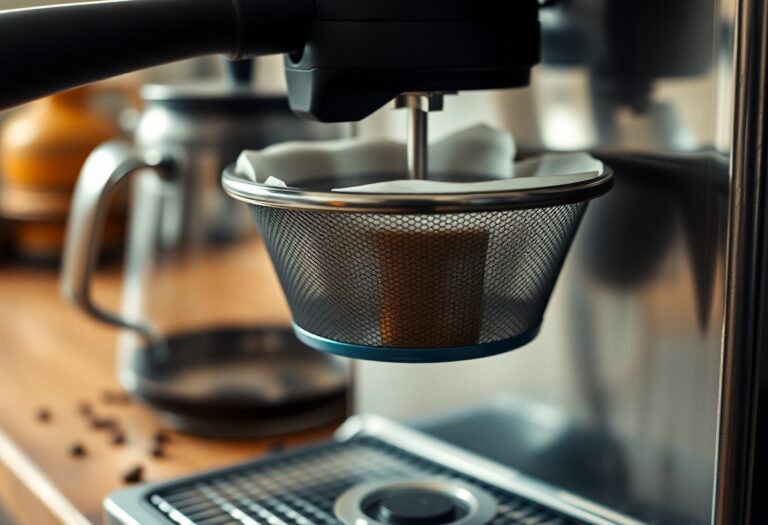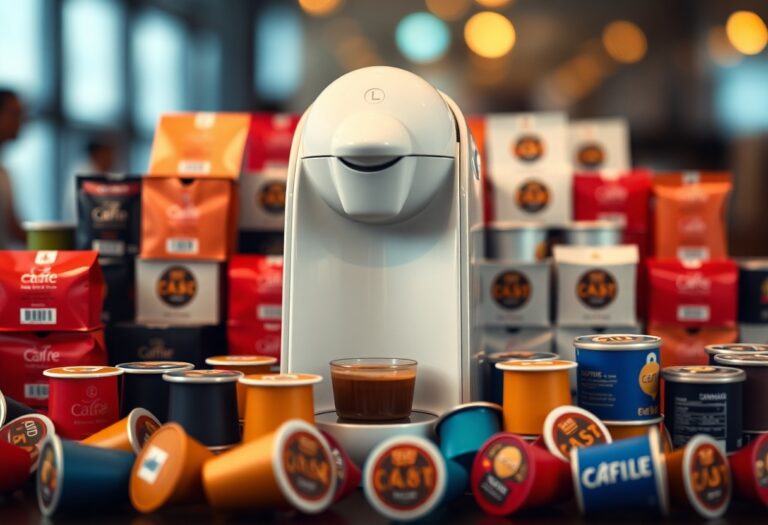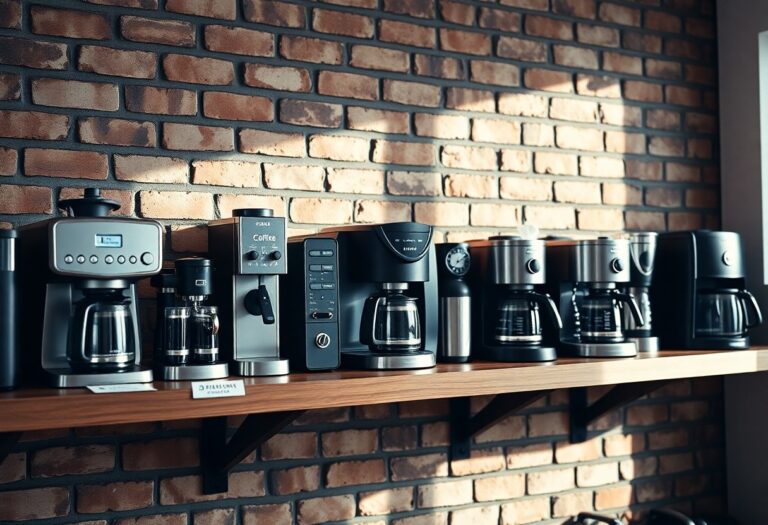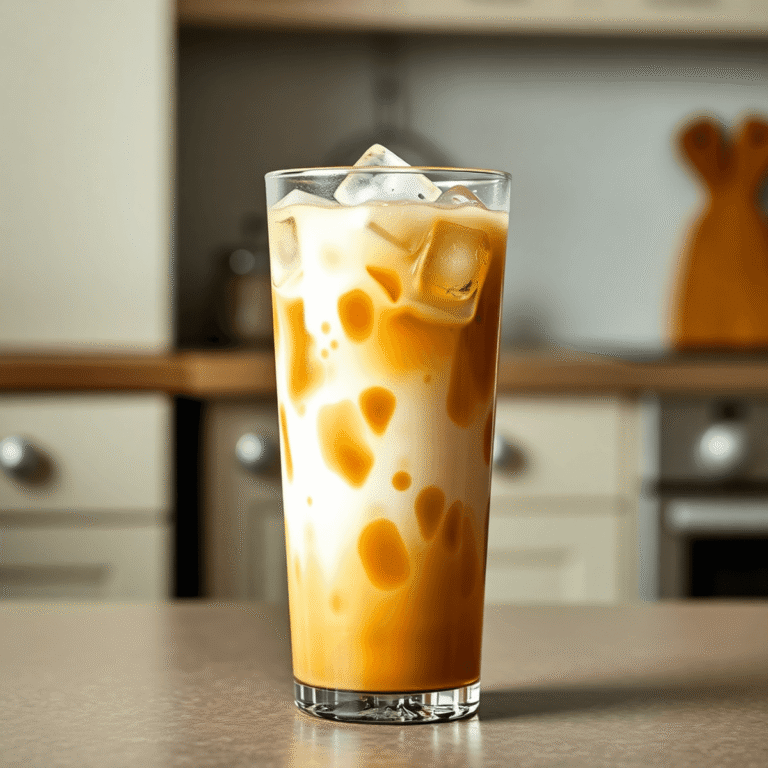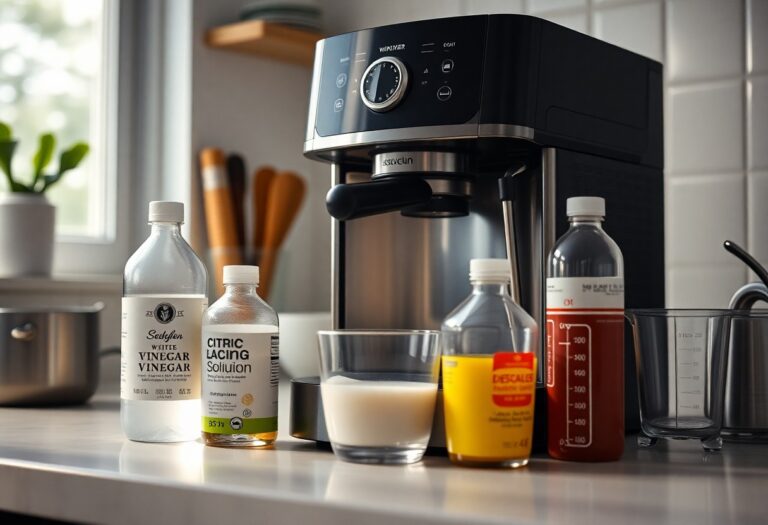What is a Filter Coffee Machine – Paper Filter System
You may have encountered a filter coffee machine using a paper filter system and wondered how it brews that perfect cup of coffee. This machine relies on a simple yet effective method, where hot water is poured over ground coffee nestled in a disposable paper filter. As water seeps through, it extracts rich flavors while keeping sediments at bay. This results in a smooth, clean cup that enhances your coffee experience. Understanding this process can elevate your daily ritual and help you choose the right machine for your kitchen.

Key Takeaways:
- A filter coffee machine uses a paper filter to separate coffee grounds from brewed coffee, resulting in a smoother taste.
- This brewing system typically involves hot water dripping through coffee grounds, allowing extraction of flavors and oils while leaving sediment behind.
- Filter coffee machines are user-friendly, often equipped with programmable settings for convenience and consistency.
- Maintenance is straightforward, requiring regular replacement of paper filters and occasional cleaning of the machine components.
- This method of brewing is popular for making larger quantities of coffee, perfect for sharing or serving multiple cups at once.
The Anatomy of a Paper Filter Coffee Machine
A paper filter coffee machine boasts several key components that work in harmony to produce a delicious brew. Each part, from the water reservoir to the carafe, plays a distinct role in ensuring your coffee is extracted perfectly. For more insights on the intricacies of filtration systems, check out Why We Filter.
Key Components and Their Roles
The primary components of a paper filter coffee machine include the water reservoir, which holds the water to be heated; the brew basket, where you place the paper filter and ground coffee; and the hot plate, which keeps the brewed coffee warm. Each element is important for ensuring the perfect extraction and serving of coffee, contributing to the overall taste and aroma.
How the Paper Filter Works Within the System
The paper filter plays an important role in the brewing process by allowing water to flow through while trapping coffee grounds and impurities. As hot water passes through the filter, it extracts important oils and flavors from the coffee, resulting in a clean and vibrant brew.
When you brew coffee using a paper filter, the process begins as water is heated and then poured over the coffee grounds. The paper filter prevents the grounds from entering your coffee, while its porous nature allows soluble compounds to pass through. This filtration method not only helps in achieving a clear cup but also minimizes bitter notes, delivering a smoother taste. Additionally, paper filters can absorb oils that contribute to a heavier mouthfeel, making them ideal for those who prefer a lighter brew. This combination results in a flavorful and aromatic cup of coffee that many coffee lovers cherish.
Brewing Mechanics: The Pour-Over Technique
The pour-over technique captures the essence of filter coffee brewing by allowing you complete control over the extraction process. This method involves pouring hot water uniformly over the coffee grounds, facilitating an even extraction that highlights the coffee’s innate flavors and aromas. When executed correctly, you extract the desired notes while minimizing bitterness, achieving a clean and rich cup. Mastering this technique opens up a world of nuance in your coffee experience, inviting you to explore different beans and grind sizes.
The Importance of Water Temperature and Quality
Water quality and temperature significantly influence your brewing results. Here’s a breakdown of key factors:
| Factor | Impact on Brewing |
|---|---|
| Temperature | Optimal brewing occurs between 195°F and 205°F, balancing extraction and flavor. |
| Water Quality | Use filtered water to eliminate impurities that can affect flavor, such as chlorine. |
Timing and Flow Rate: Mastering the Brew
Achieving the ideal balance of timing and flow rate directly affects how well your coffee extracts flavors. A slow, steady pour allows the coffee grounds to saturate evenly, promoting a thorough extraction. Aim for a total brew time of around 3 to 4 minutes, which often includes blooming—a pre-wet stage that enhances flavor extraction by releasing carbon dioxide trapped in the coffee. Adjusting your pouring rate and angle can further influence the flow, allowing you to customize the beverage to your preference.
The timing and flow rate during the pour can dictate not just the strength but also the body and crispness of your brew. For instance, increasing the water flow will yield a lighter flavor, while slowing it down intensifies the richness and boldness of the coffee. Experimenting with these variables allows you to discover your ideal cup, as slight adjustments can lead to distinctly different flavor profiles. Engaging with this process can transform your coffee-making from a mundane task into a refined craft.

Flavor Engineering: How Paper Filters Influence Taste
The choice of paper filters plays a significant role in shaping the flavor profile of your brew. Paper filters excel at absorbing oils and fine particles, which can lead to a cleaner cup, often highlighting the coffee’s inherent acidity and subtle tasting notes. This results in a bright and crisp flavor that enthusiasts may prefer, particularly with light and medium roasts. Additionally, by controlling how the water interacts with the coffee grounds, paper filters help prioritize specific flavor compounds, allowing your chosen beans to shine through.
The Separation of Oils and Solubles
Paper filters effectively separate oils and solubles from the coffee grounds during brewing, creating a cup that’s less oily compared to metal filters. This process means you’ll notice a more pronounced acidity and lighter body, which often amplifies the more complex flavor notes of your coffee. Oily compounds, known for their rich flavors, may be trapped for more delicate nuances to emerge, making your coffee experience cleaner and more refreshing.
Comparing Flavor Profiles: Paper Filter vs. Metal Filter
When evaluating flavor profiles, a key difference arises between paper and metal filters in your brew. Paper filters yield a lighter, cleaner cup that emphasizes brightness and acidity, while metal filters create a fuller-bodied, richer experience by allowing more oils to remain in your coffee. Thus, the choice between these filter types often depends on personal taste preferences and the specific characteristics you wish to highlight in your coffee.
| Paper Filter | Lighter, cleaner cup with enhanced acidity and clarity |
| Metal Filter | Fuller-bodied, richer flavor with pronounced oils and depth |
Both paper and metal filters offer unique advantages, aligning with different brewing goals. For instance, if you enjoy bright, fruity coffees or wish to appreciate nuanced tasting notes, paper filters excel in showcasing these qualities. Conversely, if you prefer a creamier, more indulgent cup, metal filters can provide the body and richness you desire. Your personal preferences will ultimately guide the choice, but experimenting with both can lead to delightful discoveries and a deeper understanding of your coffee’s capabilities.
| Preferred Taste | Recommended Filter |
| Bright and tangy | Paper filter |
| Rich and creamy | Metal filter |
Maintenance and Best Practices for Longevity
Your filter coffee machine will serve you best with proper maintenance and care routines that enhance its durability. Implementing best practices not only optimizes the brewing process but also prolongs the lifespan of your machine. Regular cleaning and mindful usage will ensure that you consistently enjoy excellent coffee without unwanted flavors or malfunctions.
Cleaning Techniques and Frequency
Cleansing your coffee machine should occur every couple of weeks to prevent buildup and maintain great taste. Begin by washing the removable parts like the carafe and filter basket with warm soapy water. For optimal results, use a vinegar solution monthly to descale the machine. This routine does wonders in keeping your coffee tasting fresh and vibrant.
Storage and Usage Tips
Storing your filter coffee machine properly contributes significantly to its longevity. Placing it in a cool, dry area reduces the risk of moisture damage. Avoid leaving it in direct sunlight or near heat sources. Additionally, unplugging the machine after each use will safeguard it from electrical surges and potential wear, ensuring that your machine remains in peak condition. The
- cool, dry area prevents moisture damage.
- unplugging protects against electrical surges.
- avoid heat sources to maintain durability.
Using your coffee machine wisely also plays a substantial role in enhancing its lifespan. Regularly check for any signs of wear and tear on parts like the filter holder and water reservoir. Avoid overfilling the reservoir beyond its recommended capacity, as this can lead to spills and mid-brew interruptions that might damage the machine. The
- regular checks help identify wear and tear.
- recommended capacity prevents spills and damages.
- avoiding overfilling keeps the brewing process smooth.
The Environmental Perspective: Sustainability of Paper Filters
The impact of paper filters on the environment is an ongoing discussion in the coffee community. Many consumers are concerned with sustainability, leading to an increase in biodegradable options that break down naturally over time. For a deeper understanding of sustainable choices, refer to The Complete Guide to Coffee Filters, which explores the environmental footprints of various filter types.
Biodegradable Options and Their Impact
Opting for biodegradable filters can significantly reduce your carbon footprint. These filters, often made from natural fibers, decompose within a few months instead of lingering in landfills for years. When you choose biodegradable options, you’re contributing to a more sustainable coffee culture while still maintaining the convenience of a paper filter system.
The Trade-offs Between Convenience and Eco-friendliness
While biodegradable filters offer an eco-friendly alternative, they sometimes come with trade-offs in convenience and price. Standard paper filters might be more accessible and cheaper, but they can contribute to waste over time. Balancing your desire for convenience with the need for sustainability means weighing the costs and benefits of your filter choices.
Choosing between convenience and eco-friendliness can often feel challenging. For instance, while disposable paper filters are easy to use and require minimal cleanup, they generate waste that adds up over time. On the other hand, biodegradable filters may not always be as readily available, or you might find them at a premium price. Additionally, the composting process for these biodegradable options depends on proper disposal methods, which can be hit-or-miss depending on your local facilities. Ultimately, assessing your priorities will guide your decision-making on which filter aligns best with both your lifestyle and values.
To wrap up
Summing up, a filter coffee machine with a paper filter system provides you with a convenient and efficient way to brew coffee. By using paper filters, you enhance the flavor profile of your coffee by trapping oils and sediments, resulting in a cleaner cup. This system is particularly user-friendly, allowing you to easily dispose of used filters without any mess. As you explore options for your daily brew, consider the benefits of a filter coffee machine with a paper filter system to elevate your coffee experience.
FAQ
Q: What is a filter coffee machine with a paper filter system?
A: A filter coffee machine with a paper filter system is an appliance designed to brew coffee by passing hot water through ground coffee contained in a paper filter. The paper filter captures coffee grounds while allowing brewed coffee to flow into a carafe or pot, resulting in a smooth and sediment-free beverage. This system is popular for its ease of use and ability to produce a consistent flavor profile.
Q: How does the paper filter system work in a filter coffee machine?
A: In a filter coffee machine, the paper filter is placed in a designated basket where ground coffee is added. When the machine is activated, water is heated and then poured over the coffee grounds in a controlled manner. The hot water extracts oils and flavors from the coffee grounds and passes through the paper filter, which traps the solids. The brewed coffee collects in the carafe below, ready to be served.
Q: What are the benefits of using a paper filter in coffee brewing?
A: Using a paper filter offers several advantages, including reducing the amount of coffee oils and sediments in the final brew, resulting in a cleaner taste. Additionally, paper filters help to keep the coffee’s acidity balanced and can enhance the overall flavor profile. They are also convenient, as they can be easily disposed of after use, making cleanup faster and simpler.
Q: Are there any disadvantages to using paper filters in a coffee machine?
A: While paper filters provide a clean cup of coffee, there are some disadvantages to consider. For instance, they may absorb some of the natural oils from the coffee beans, which can affect the flavor. Some coffee enthusiasts prefer metal filters, which allow more oils to pass through, giving the final brew a fuller body. Additionally, the need to purchase disposable paper filters can add ongoing costs to your coffee brewing routine.
Q: Can I use ground coffee other than standard drip coffee in a paper filter system?
A: Yes, you can use a variety of ground coffees in a filter coffee machine with a paper filter system. However, it’s important to ensure that the grind size is appropriate; medium grind is typically best for drip coffee makers. Specialty coffee blends, flavored coffees, or even single-origin beans can all be used, but experimenting with different types may require adjusting the brew time or coffee-to-water ratio to achieve the desired taste.


